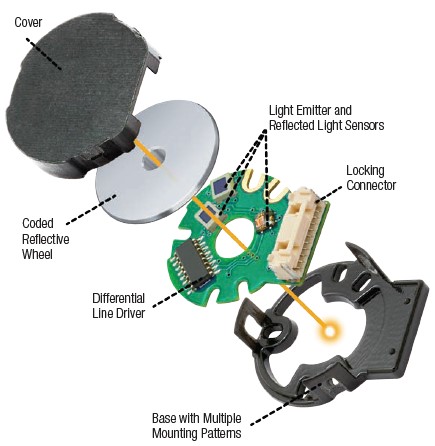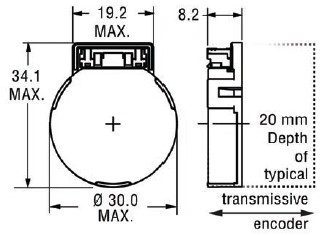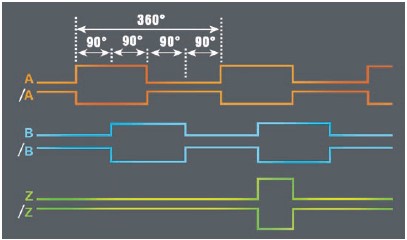Traditionally, Reflective Encoders have been considered a lower end option used when cost was more important than options. The Pittman E30C and E30D reflective encoder can turn that theory upside down.
 Choosing an Encoder
Choosing an Encoder
When choosing an encoder, many factors influence the decision. Is the requirement absolute or incremental, single-sided or with differential compliments, index or no index, and of course, cost.
There are several different encoder technologies on the market such as optical transmissive, optical reflective, magnetic and capacitive – each with various strengths and weaknesses. The Pittman E30C and E30D Encoder Series uses the latest optical reflective technology and is designed to combine as many
advantages as possible into one affordable package.
 Package Size
Package Size
Often, when designing motion control systems, engineers will decide they need an encoder only after their system is laid out and space is limited. This puts a system designer in a situation where they have to fit an encoder into a very tight space greatly limiting the available choices.
Transmissive Encoders, a common choice, operate by shining a light through a code-wheel that either allows light to pass or doesn’t in equal increments. Then, using a detector on the other side, it will output a square wave pulse. The stack-up of required components ensures that the typical transmissive encoder (in the 30mm diameter size range) will be 20mm or over, in height.
Magnetic encoders, which typically use hall sensors to detect the poles of a rotating magnet, will use an interpolation circuit to output the square wave pulse and are slightly better in size but still tend to have significant height. By contrast, reflective encoders work by shining a light onto a code-wheel that has varying reflective and non-reflective bars and then uses a photo detector in the same plane as the emitter to produce the incremental signal which significantly reduces the stack height. Typically, even with this space saving benefit, encoder packages have been designed with oversized code-wheels and large air gaps, and may have thickness of 12mm or more. The E30 reflective series is optimized for space and has a height of only 8mm making it among the thinnest encoder options available and allowing design engineers maximum flexibility.
 |
| Figure 1. E30 Series components include optimized reflective technology. |
| |
| |
 |
| Figure 2. The E30 profile depth (shown in mm) is significantly reduced – 60% smaller than a typical transmissive encoder. |
| |
| |
 |
| Figure 3. Output channels also include an index channel and higher CPR capabilities for maximum precision. |
 Output Channels
Output Channels
The choice of output is crucial to the design of a motion control system.
The number of square wave pulses per revolution (known as “Cycles Per Revolution” or CPR) determines the maximum precision available to the control system. Having two channels offset from one another by 90°e (known as quadrature), gives the control software a way to determine the direction of motor rotation. For example, if the A channel leads the B channel the motor rotates clockwise and vice versa. Differential complimentary channels can be used by the control system to filter high frequency electrical noise.
The control system can subtract the compliment and since noise will affect all channels in the same direction, it will be zeroed out while the resulting square wave will be doubled and electrically clean. An index pulse, a square wave pulse that occurs once per revolution is very helpful in measuring motor speed since one pulse means one revolution. Historically, the index pulse was not available in reflective technology and so if that were required, a design engineer would have had to choose another option. Now with new technology, it is possible to get all the benefits of the reflective technology as well as an index channel.
One of the other historical downsides of reflective technology is that it was typically limited to lower CPR due to lower frequency response of the electronics. Now using the latest in reflective technology, you can choose quadrature output at 200, 250, 256, 400, 500, 512, 1000, 1024, 2000, and 2048 CPR, as well as the third, index channel for 500 CPR and above, and differential complimentary channels for all. In addition, these options are all available on the same printed circuit board so any encoder option can be exchanged with any other allowing the design engineer a whole new level of flexibility.
 Latest Encoder Chip Technology
Latest Encoder Chip Technology
To achieve enhanced performance, the E30D encoder makes use of the world’s smallest three channel optical encoder.
This encoder chip has been designed to integrate an interpolation circuit and an index output all while shrinking the dimensions to 3.95mm by 3.40mm by 0.95mm tall. Additionally, the state width error values have been reduced by more than half and the rise time has improved 5 fold, from up to 500ns down to less than 100ns. Using a combination of advanced circuitry, better lens focus, higher native code track density, and tighter gap, this encoder chip is now as good or better than the transmissive encodes typically used when higher CPR’s and index outputs are required.
 Mounting and Wiring
Mounting and Wiring
Inevitably, different encoders will have different connectors but the goal of the E30 series is to be as flexible as possible while offering the maximum benefit. The connectors are no exception.
 |
| Figure 4. The E30 series uses a 10-pin locking connector which forms a robust and secure connection. |
Motors in specific and motion control systems generally are subject to vibration and other environmental factors that can impact the wiring. This has a tendency to loosen standard connections over time and possibly lose connectivity all together. Using a low profile Molex® CLIK-Mate™ connector to provide a positive locking connection ensures that there will be no unplugging of the wires due to either vibration or other mechanical action up to and including strain. In addition, the chosen connector always has the same 10 pin arrangement so, like the other choices, all encoders are interchangeable. This is true for both the standard radial lead wire arrangement and the axial lead wire arrangement.
With regard to mounting, there are nearly unlimited number of arrangements on motors so it’s important to be as comprehensive as possible when designing the mount system which is what the E30 series tries to accomplish. It is designed to manage either a 3 hole bolt pattern or a two bolt pattern with slotted holes to accommodate multiple bolt circles. With everything locked with screws, the encoder is protected against components moving in process, a common problem in some encoders that use plastic friction fits instead.
Whether it’s high CPR or an index channel, it’s time to reevaluate reflective technology. The Pittman E30C and E30D Encoders are affordable, available in many configurations, and because they come fully integrated into a motor system, arrive to the user fully assembled and 100% tested.
Click here to download PDF version.